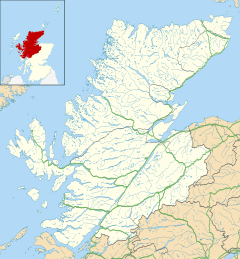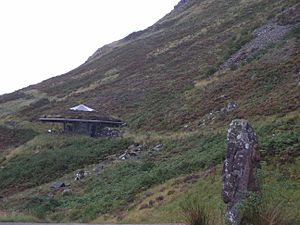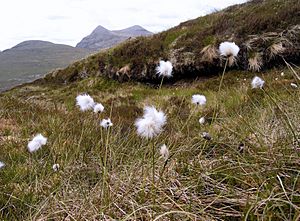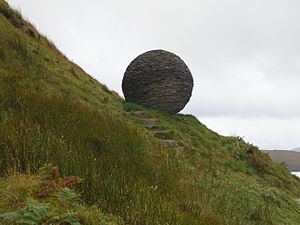Knockan Crag facts for kids
Quick facts for kids Knockan Crag National Nature Reserve |
|
|---|---|
|
IUCN Category III (Natural Monument)
|
|
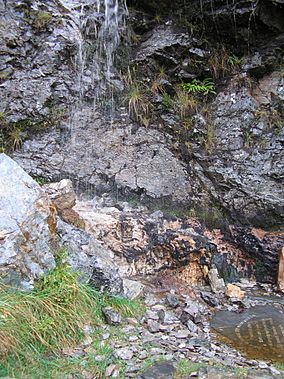
The Moine Thrust fault at Knockan Crag
|
|
| Location | Highland, Scotland |
| Area | 22.15 ha (54.7 acres) |
| Established | 2004 |
| Governing body | NatureScot |
| Knockan Crag | |
Knockan Crag (which means "crag of the small hill" in Scottish Gaelic) is a special place in the North West Highlands Geopark in Scotland. It's about 21 kilometers (13 miles) north of Ullapool. This area is famous for its amazing geology and a big argument from the 1800s called the 'Highlands Controversy'.
Back then, geologists noticed something strange. The rocks at the top of Knockan Crag, called Moine schists, seemed older than the rocks lower down. This didn't make sense! Scientists like Roderick Murchison and Archibald Geikie thought the rocks were just different types. But others, like James Nicol and Charles Lapworth, believed something big had moved the rocks around.
The mystery was finally solved by two geologists, Ben Peach and John Horne. In 1907, they showed that a huge "thrust fault" had happened. This was the first time such a fault was discovered anywhere in the world! It meant that older rocks had been pushed about 70 kilometers (43 miles) over the top of younger rocks because of powerful movements in the Earth's crust.
Today, Knockan Crag is a National Nature Reserve (NNR) because of its unique geology. NatureScot owns and manages the site. There's a car park and a visitor center where you can learn all about the rocks and the 'Highlands Controversy'. You can also walk on three marked trails and see artworks inspired by the landscape.
Geological Wonders
Knockan Crag is a key part of the Moine Thrust Belt. For a long time, scientists were puzzled by the rocks here. They saw old, hard rocks (gneisses and schists) sitting on top of much younger, softer rocks.
At first, some geologists, like Roderick Murchison, thought the rocks had just changed over time. But after more study, James Nicol realized that the rocks had been moved by a powerful force. This started the "Highlands Controversy". Charles Lapworth also agreed with this idea, comparing it to similar rock movements he knew about in the Alps.
In the 1880s, two geologists, Ben Peach and John Horne, mapped the area in great detail. They proved that the rocks had been pushed over each other. Even Archibald Geikie, who first disagreed, was convinced when he saw their work.
In 1884, Peach and Horne published their findings. Geikie then used the term "thrust-plane" for these low-angle faults, where rocks slide over each other. By 1888, the term "Moine Thrust" was used for this huge break in the rocks.
Discovering the Moine Thrust Belt was a huge moment in geology. It showed that rocks could move horizontally over very long distances, not just up and down. This changed how scientists understood how mountains and landscapes are formed. Peach and Horne's detailed work was published in a famous book in 1907.
There's even a monument to Peach and Horne's amazing work at Inchnadamph, a few miles north of Knockan Crag.
Plants and Animals
The types of plants you see at Knockan Crag depend a lot on the rocks underneath. Areas with limestone have richer soil. This means you'll find more kinds of plants there, like mountain avens and rock sedge.
But areas with Moine schists have wet, boggy soil. Here, you'll mostly see plants that like wet conditions, like blanket bog plants. You can clearly see this change in plants on the plateau above the crags, where small limestone hills are surrounded by peaty areas.
Many different birds live at Knockan Crag. You might spot a kestrel, raven, or ring ouzel. Smaller songbirds like dunnock, wren, stonechat, and meadow pipit are also common. In winter and spring, red-throated and black-throated divers visit a nearby loch, so you might see them from the crag. Red deer also often walk through the reserve.
Protecting Knockan Crag
Knockan Crag first became part of the Inverpolly national nature reserve in 1962. Later, in 2004, it was decided that Knockan Crag was so special that it should be its own National Nature Reserve. So, on February 24, 2004, it officially became the Knockan Crag National Nature Reserve.
The reserve is also part of the larger Knockan Cliffs Site of Special Scientific Interest. It's recognized as a Category III protected area by the International Union for the Conservation of Nature. This means it's an important place for protecting natural features. Knockan Crag is also part of the North West Highlands Geopark, which is a member of a worldwide network of geoparks.
See also
 In Spanish: Knockan Crag para niños
In Spanish: Knockan Crag para niños


